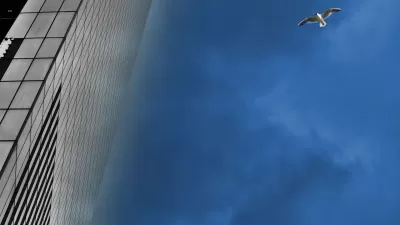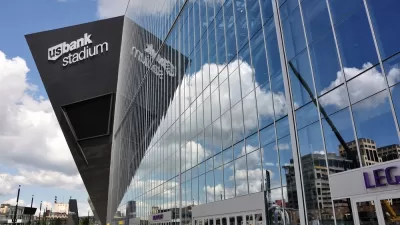Reflective glass high-rises kill millions of birds each year, but bird-friendly design can save birds and reduce energy consumption.

Architects know how to stop birds from flying into buildings, writes Alexandra Lange—but "those standards clash with the big glass and big views that clients associate with big money." To prevent birds from mistaking reflective glass windows for trees or open space, designers can use patterned glass, exterior screens, and reduced lighting. But according to Kate Orff of architecture and design studio SCAPE, an emphasis on giant glass panes has turned Manhattan into "a giant bird killer."
During last September's fall migration season, volunteers with NYC Audubon's collision monitoring project documented hundreds of bird strikes at the World Trade Center, and a heightened interest in birdwatching during the pandemic has led more people to pay attention to, and want to save, urban birds.
In early 2021, New York City implemented legislation that mandates bird-friendly design in new buildings and requires city buildings to turn off nonessential lighting at night during migration season.
The best example of a bird-safe retrofit, from the point of view of scale and effectiveness, is Manhattan’s Javits Center, which spent five years replacing the convention center’s clear glass with panels covered in tiny ceramic dots as part of a $500 million environmental retrofit that also added a 6.75-acre green roof. Almost imperceptible to the human eye, those dots nonetheless cut bird death by 90% — and energy consumption by 26%.
The article points out that bird collisions don't just happen with high-rise buildings, but there are low-cost changes homeowners can make to reduce bird strikes at home, such as safety netting or patterned window films.
FULL STORY: Buildings Don't Have To Be Bird-Killers

Study: Maui’s Plan to Convert Vacation Rentals to Long-Term Housing Could Cause Nearly $1 Billion Economic Loss
The plan would reduce visitor accommodation by 25,% resulting in 1,900 jobs lost.

North Texas Transit Leaders Tout Benefits of TOD for Growing Region
At a summit focused on transit-oriented development, policymakers discussed how North Texas’ expanded light rail system can serve as a tool for economic growth.

Using Old Oil and Gas Wells for Green Energy Storage
Penn State researchers have found that repurposing abandoned oil and gas wells for geothermal-assisted compressed-air energy storage can boost efficiency, reduce environmental risks, and support clean energy and job transitions.

Santa Barbara Could Build Housing on County Land
County supervisors moved forward a proposal to build workforce housing on two county-owned parcels.

San Mateo Formally Opposes Freeway Project
The city council will send a letter to Caltrans urging the agency to reconsider a plan to expand the 101 through the city of San Mateo.

A Bronx Community Fights to Have its Voice Heard
After organizing and giving input for decades, the community around the Kingsbridge Armory might actually see it redeveloped — and they want to continue to have a say in how it goes.
Urban Design for Planners 1: Software Tools
This six-course series explores essential urban design concepts using open source software and equips planners with the tools they need to participate fully in the urban design process.
Planning for Universal Design
Learn the tools for implementing Universal Design in planning regulations.
Ascent Environmental
Borough of Carlisle
Institute for Housing and Urban Development Studies (IHS)
City of Grandview
Harvard GSD Executive Education
Toledo-Lucas County Plan Commissions
Salt Lake City
NYU Wagner Graduate School of Public Service





























